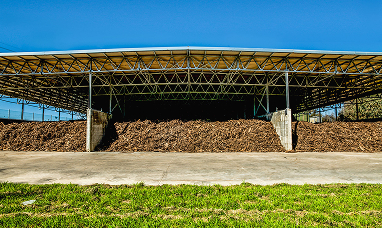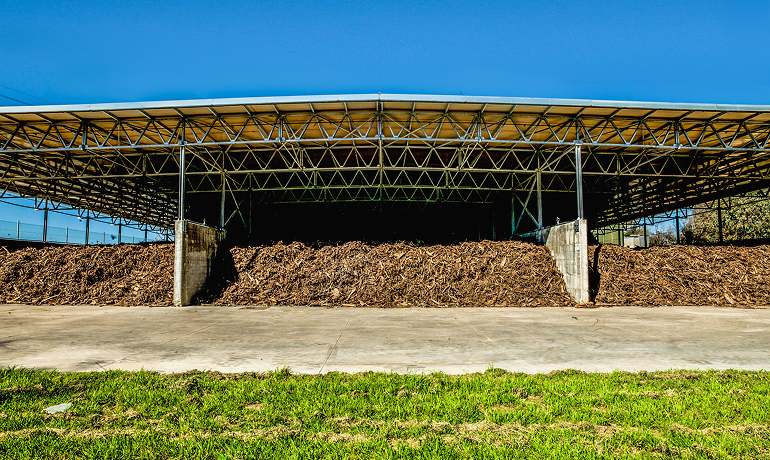Our composting plants
for integrated waste management
Our facilities are located in Aprilia, Monterotondo Marittimo and Orvieto.
The transformation of organic waste into compost, through dedicated treatment plants that play a key role in the entire process, represents a fundamental element for sustainable waste cycle management.


A composting plant is designed to accelerate the natural process of turning organic residues into compost, a material rich in organic matter and nutrients used as a fertiliser (soil conditioner). This process, known as composting, occurs in controlled environments through the activity of microorganisms such as bacteria and fungi.
Composting plants can vary in complexity and scalability depending on the amount of organic waste handled.
Our facilities are located in Aprilia, Monterotondo Marittimo and Orvieto.
Area served: primarily municipalities in Lazio Region
Adress: via Ferriere-Nettuno, Km 15, 04011 Aprilia (LT)
Opening hours: mon-sat 07:00 a.m. - 07:30 p.m.
Phone: 06 57 997 800
To send an e-mail click here
The integrated anaerobic digestion and composting plant has an authorised capacity of 120,000 t/y. The anaerobic digestion section only treats organic fraction from separate collection and green manure, while the composting-only section also treats sludge from civil sewage treatment plants and agro-food waste. Two different types of compost are then produced: ACM (mixed composted soil improver) and ACF (composted soil improver with sludge). Three cogenerators installed, with a total capacity of 3.0 MW, allow the production of about 23,000 MWh/year of electricity (in addition to thermal energy recovery).
In 2021, a compost bagging line was also installed, with the aim of activating additional market outlets for the placement of the organic fertilizer, and an SRF production line from process waste, which allows waste to be sent to the San Vittore del Lazio waste-to-energy plant. Furthermore, in 2023 Lazio Region authorized additional plant optimizations and operational improvements that will make the plant more efficient (essentially found in the installation of a second press, a second weighing station, a wheel washing system, and a different distribution of flows in the plant).
tonnes of authorized waste capacity
tonnes of compost production
Area served: primarily municipalities in Tuscany Region
Adress: Località Carboli snc, 58025 Monterotondo Marittimo (GR)
Opening hours: mon-sat 07:00 a.m. - 07:30 p.m.
Phone: 06 57 997 800
To send an email click here
The Monterotondo Marittimo composting plant, which underwent revamping works in 2019, is equipped with the most advanced technologies on the market. By exploiting combined anaerobic-aerobic technology achieves a treatment capacity of 70,000 tons/year of waste (consisting of organic fraction, clippings and prunings, and sludge), with a total annual electricity production of about 6 GWh, with recovery of the thermal energy produced.
The plant provides significant environmental benefits by turning organic waste into useful fertiliser for agriculture (compost) and producing electricity from renewable sources through the energy valorisation of biogas.
tonnes of authorized waste capacity
tonnes of compost production
Area served: Primarily municipalities in Tuscany Region
Adress: Località Pian del Vantaggio 35/A, 05018 Orvieto (TR)
Opening hours: mon-sat 07:00 a.m. - 07:30 p.m.
Phone: 06 57 997 800
To send an email click here
The main activities carried out at the plant include the sorting and recycling of urban waste, anaerobic digestion and quality composting of recycled waste and the disposal of non-dangerous, special waste in landfills. The main objectives, in compliance with current legislation, is to enhance material and energy recover and reduce the amount of disposed waste in landfills.
The two plants for energy production in Orvieto are both powered by biogas produced by the anaerobic section of the treatment plant and by landfills. In 2023, the amount of incoming waste in the plant was 99,513 tonnes. 60% (approximately 59,700 tonnes) was disposed in landfills, while the rest of it was almost entirely sent to the anaerobic digestion and composting section of the treatment plant for biogas and compost production.
tonnes of authorized waste capacity
tonnes of compost production